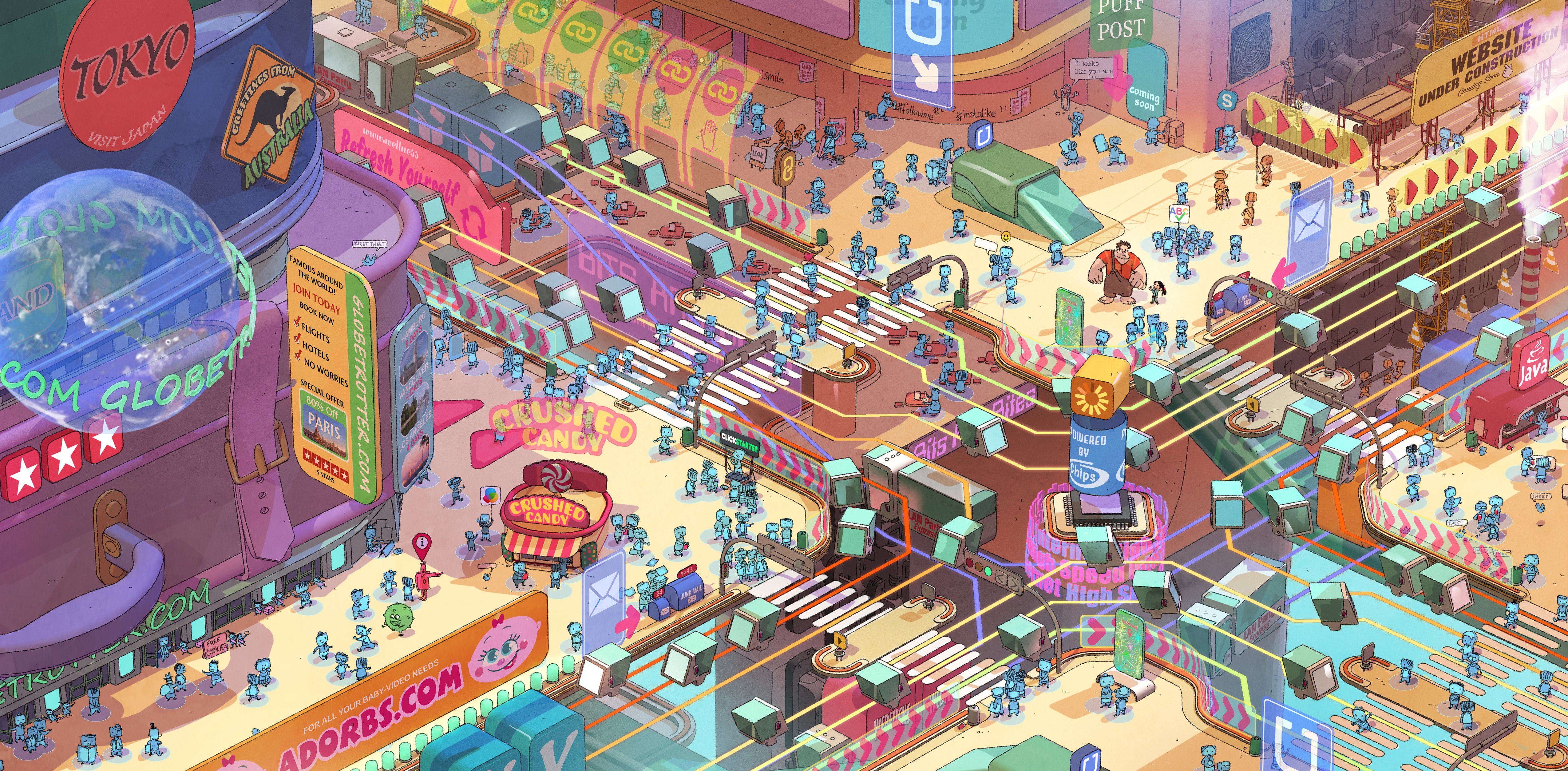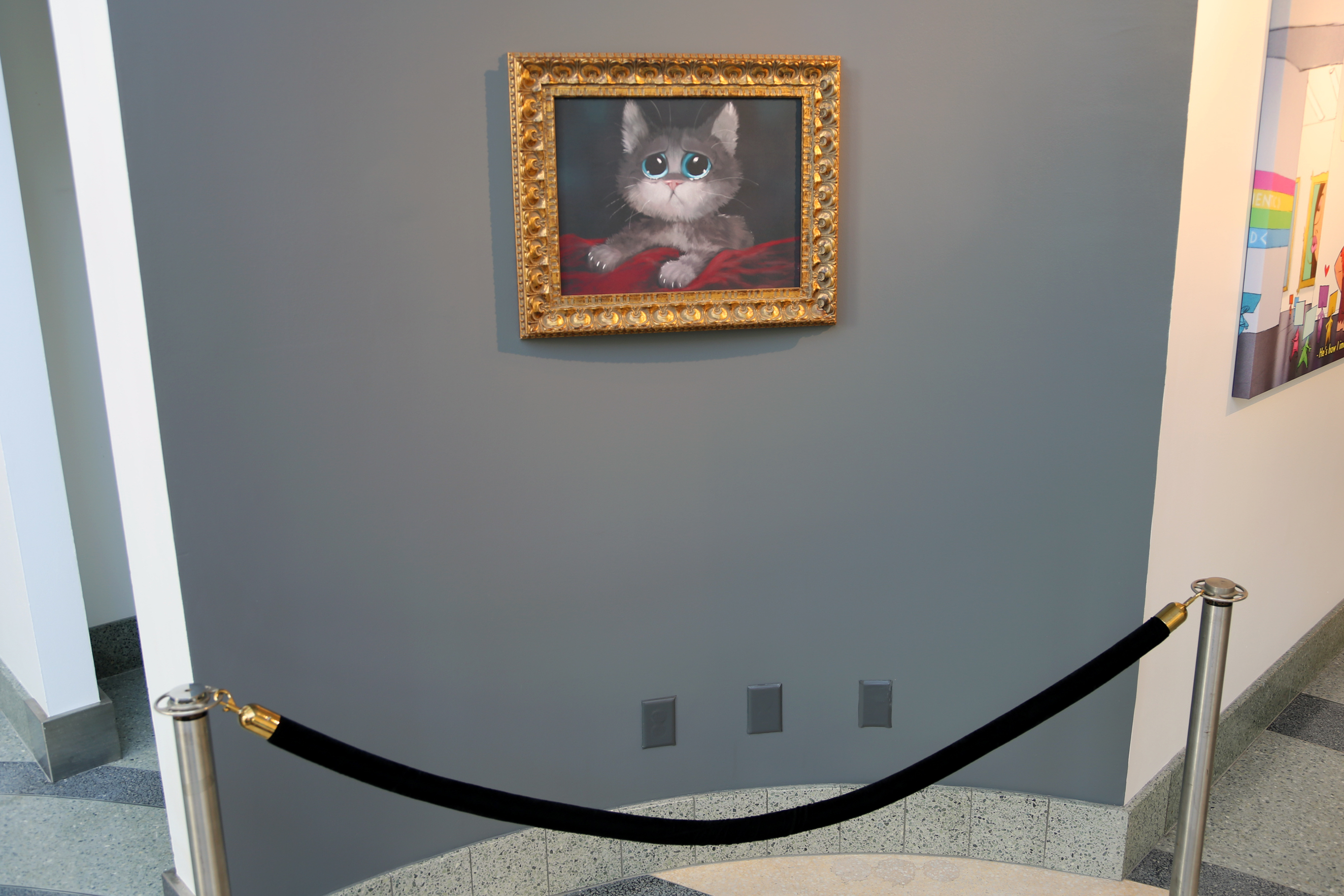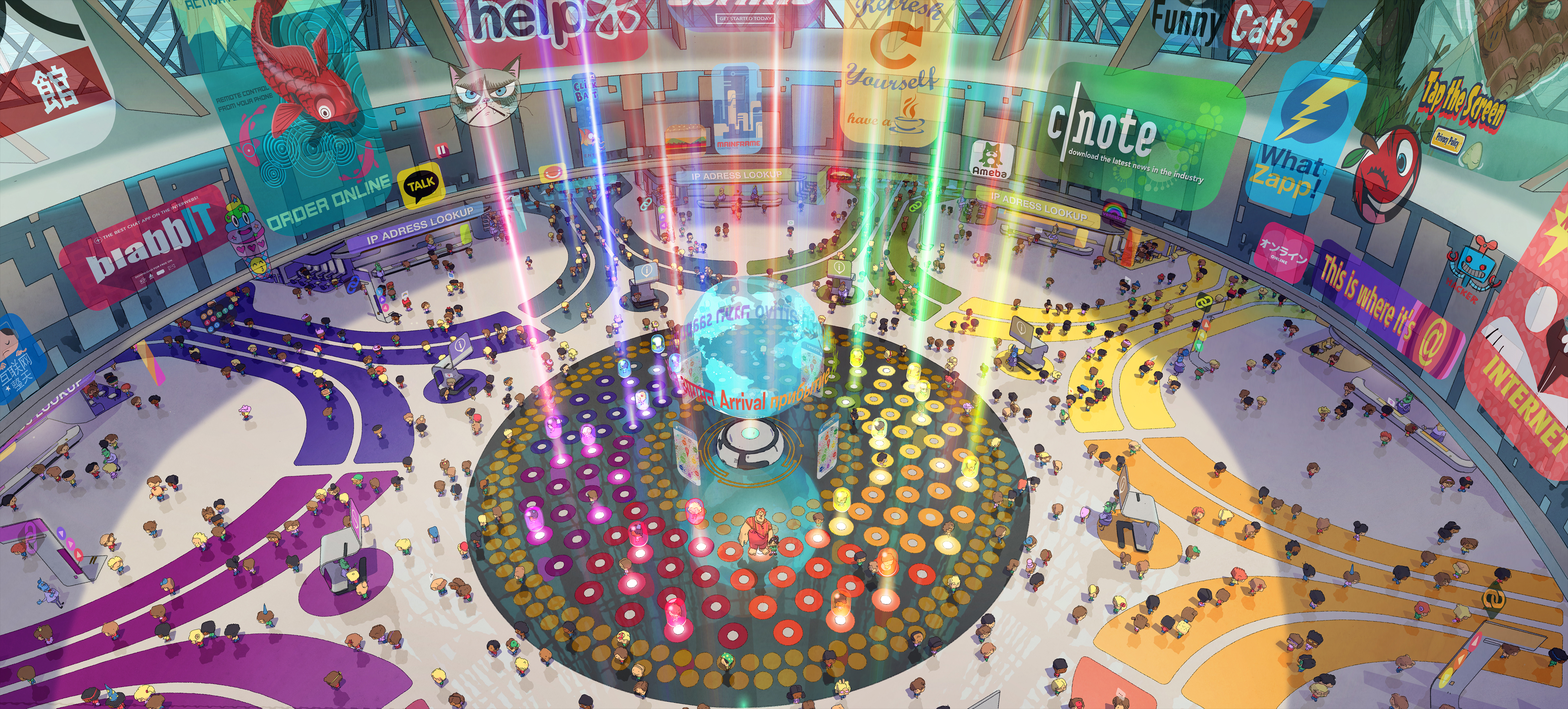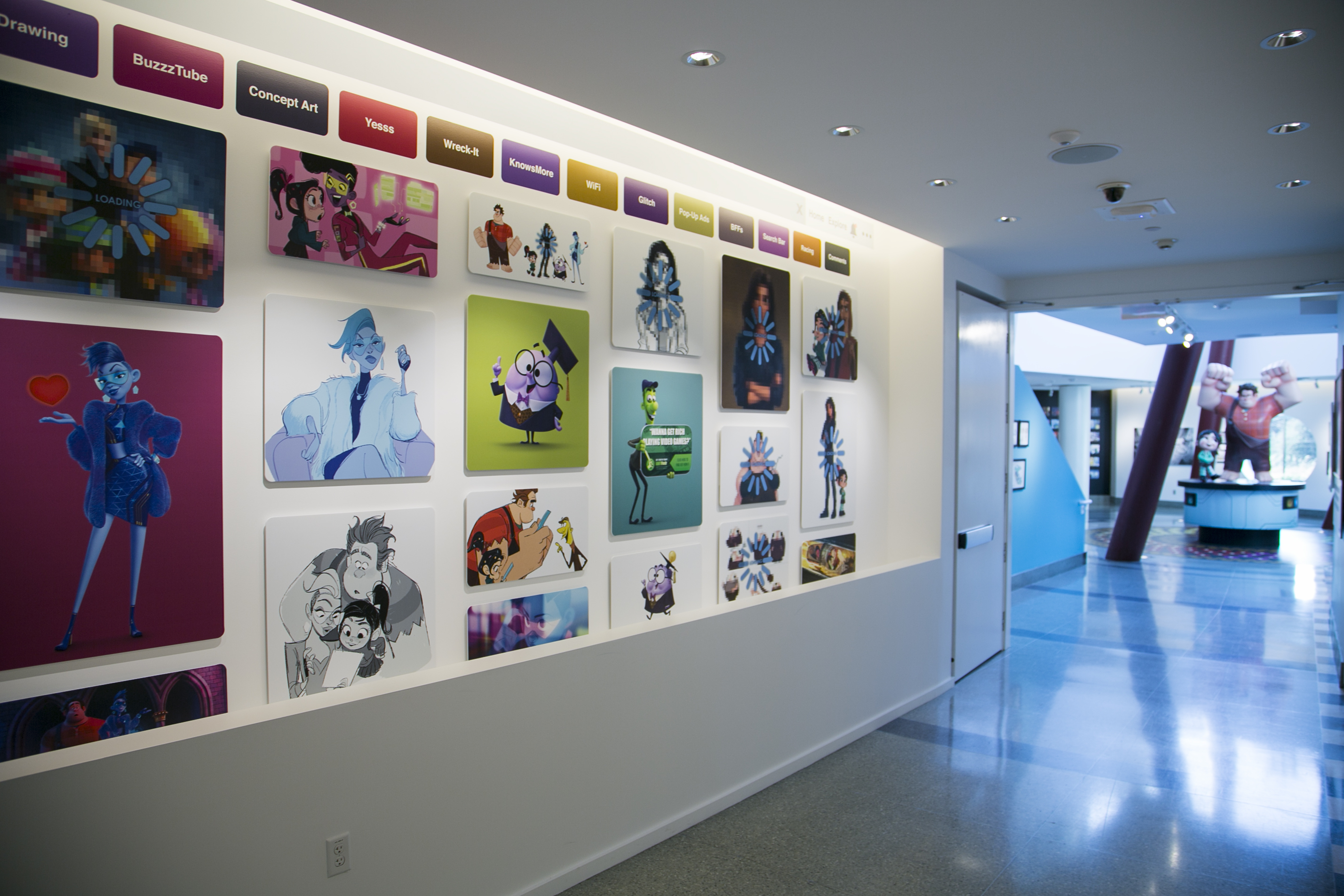KnowsMore, What Does the Internet Look Like?
KnowsMore, the lovable search bar host with all the answers to your most pressing questions, retrieved the following results to the question: What Does the Internet Look Like?

RALPH BREAKS THE INTERNET - Internet surface web environment visual development by Matthias Lechner (Art DIrector, Environments) ©Disney. All Rights Reserved.
In Disney’s Ralph Breaks the Internet, audiences will be transported to a world that is both familiar and new. “When it came time to imagining the world of the Internet, we took a few different approaches early on in our process,” Director Rich Moore explained at a press event at Walt Disney Animation Studios in August. “We started by asking ourselves ‘How are we going to make our animated version of the Internet feel like the Internet that you and I use everyday?’”
“One of the very first things we did was talk to our animation team and asked them to explore the majesty and grandeur of the Internet,” Writer Phil Johnston shared. “And we said you can do whatever you want and our team of animators, who are truly the best in the world, we gave them this free reign to do whatever they want.” The result, like the Internet itself, was a lot of cat videos.

Environment as seen at the Long Lead Press Day for RALPH BREAKS THE INTERNET at Walt Disney Animation Studios on July 31 and August 1, 2018. Photo by Alex Kang/Disney. ©2018 Disney. All Rights Reserved.
In the atrium of Walt Disney Animation Studios was a gallery of artwork from Ralph Breaks the Internet, including a velvet painting of a sad kitten behind a red rope. “The storyboard artist who first worked on the eBay scene, a great artist named Lauren MacMullen, had never bought anything on eBay, never used eBay before. So she went onto eBay and bought that painting, something very, very similar that was described as a cat with sorrowful eyes and it was the most grandiose description for a black velvet painting of a cat. And so that painting… is inspired by Lauren’s very first purchase on eBay that kicked everything off.”
Art Director Matthias Lechner had the unenviable assignment of designing the environments for the film. “When I was asked to design the Internet, the world, that was daunting and fascinating. Where do you even start? Usually we start with research so one of the things is we took a trip down to LA to One Wilshire, which is the Internet hub for Southern California. It was really interesting to see the physical side of the Internet, what a mess it is in some ways, it’s miles of cables and servers.”

RALPH BREAKS THE INTERNET - Internet landing hub environment visual development by Matthias Lechner (Art Director, Environments) ©Disney. All Rights Reserved.
Ralph and Vanellope find themselves inside the Internet after Litwalk plugs in a router to the same power strip that connects their arcade games. Like a Disney theme park, they arrive at the Internet Hub. “We wanted this huge, endless, metropolis city feel,” explains Larry Wu, Head of Environments. “But we also didn’t want them to just have buildings and the idea we got behind is that each building is a website, but the website we actually go in is not what the buildings represent. Because they’re abstract and they go to this other world like in the arcade.”
Users that Ralph and Vanellope interact with are like avatars of humans behind a mouse. These characters lead with their heads, as if they’re being pulled in the direction they’re walking. Their movements are intentionally simple and have a limited range of motion, inspired by the way we move a cursor on a webpage. Their heads are square with rounded corners, inspired by the shape of app icons on smart phones. Production Designer Cory Loftis shared that visual similarities to the short film Inner Workings aren’t pure coincidence. “It’s an odd fact that the same character designer, Ami Thompson, worked on both…. She has a very particular way that she likes to draw, but that app icon was a major inspiration. It ended up feeling slightly similar.”

RALPH BREAKS THE INTERNET - User character visual development lineup by Cory Loftis (Production Designer) ©Disney. All Rights Reserved.
The Internet is kinetic, with Users being transported between sites by self-driving cars and Netizens (resident workers inside the Internet) using clever vehicles, like email vans. Traffic lights look like the “Close, Minimize, Expand” buttons on the top of an Internet browser. Clocks are loading wheels, because the time it takes to get anywhere on the Internet is the loading time. And the Internet is constantly under construction with 3D printers working hard to expand 24/7.
“Everywhere you go in the Internet, there are videos and screens and all of those had to be designed and built,” explains Technical Supervisor, Ernie Petti. “And this was a really daunting task where at a certain point, we enlisted the entire Art Department in the [Animation] building to help with the design of all of these screens. Not just the people who are on the show typically, but basically everyone.”

RALPH BREAKS THE INTERNET - Netizens character visual development lineup by Cory Loftis (Production Designer) ©Disney. All Rights Reserved.
Head of Characters and Technical Animation, Dave Komorowski, recalled the challenge of populating this world with extras. “There was this concept that the Internet is built on top of over time. So at the beginning there might have been a MySpace and a NetScape and an AOL, but then companies have built on top of it. And so they might remain towards the bottom of the Internet and Google just kept going and would be the tallest building in the Internet.”
One of the original websites created for the film is KnowsMore, which pays homage to search engines like Ask Jeeves. Because he’s at the bottom level, he’s one of the first sites that Ralph and Vanellope interact with and he’s voiced by Disney Animation’s lucky charm, Alan Tudyk.

Environment as seen at the Long Lead Press Day for RALPH BREAKS THE INTERNET at Walt Disney Animation Studios on July 31 and August 1, 2018. Photo by Alex Kang/Disney. ©2018 Disney. All Rights Reserved.
“I really think that our talented artists here at Disney Animation are creating a world like no one’s ever seen before," Rich Moore gushed. "I think our story team has created a story that’s filled with compelling characters, comedy, and of course, a heart that you would expect from a Disney animated film.”
Check back on October 25th for more answers from KnowsMore about Disney’s Ralph Breaks the Internet. You can explore the Internet with Ralph and Vanellope in theaters starting November 21st.
